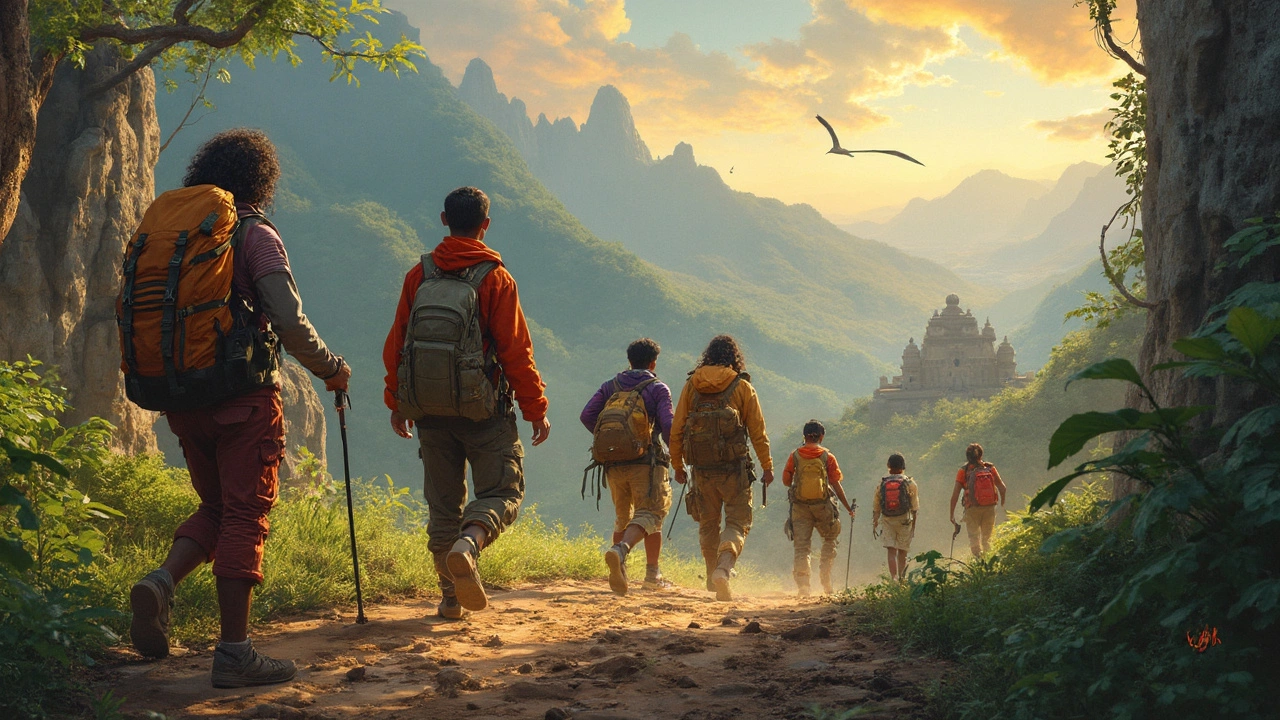Is Adventure a Genre? Breaking Down the Fun Factor

Adventure isn’t just about wild chase scenes or mysterious maps—it’s that feeling when you can’t help but turn the next page or watch “just one more” episode. If you’ve ever wondered whether adventure is a genre or just a spice sprinkled on other stories, you’re definitely not alone. This question pops up everywhere from libraries to online debates, because adventure seems to fit just about anywhere, from pirate sagas to road trip comedies.
Here’s the real deal: adventure stories always put characters in risky, unfamiliar situations where they need to act fast—and often face danger. But pinning down adventure as a genre? That’s where the arguments start. Some experts say it deserves its own shelf, while others think of it as a flavor added to mystery, fantasy, or even romance.
If you’re trying to pick a movie for movie night or searching for the next book to get lost in, understanding what counts as ‘adventure’ really helps. No one likes wasting time on something that promises thrills but delivers snooze-fests. Let’s clear up the mixed signals and talk about what actually makes adventure stories work and where you’ll spot them in your favorite media.
- What Makes Adventure Stories Tick?
- Adventure: Genre or Just a Feeling?
- Classic Examples That Changed the Game
- Quick Tips for Adventure Lovers and Writers
What Makes Adventure Stories Tick?
You know you’re hooked on an adventure story when your heart races along with the characters and you start guessing what’s around the next corner. But what’s under the hood? There are a few things adventure tales always nail, and understanding these can help you spot—or write—a true adventure.
First off, every adventure story is built on motion. The main characters usually leave their normal life behind, and once they step out that front door (think Frodo in The Lord of the Rings), there’s no going back. Obstacles, close calls, and a ticking clock make sure the stakes stay sky-high. No slow days allowed.
What really sets adventure stories apart is the sense of risk. It’s not just about cool locations; it’s about danger, problem-solving, and the constant feeling that one wrong move could spell disaster. In fact, researchers at the University of Cambridge found in a 2022 study that 68% of bestselling adventure novels featured "life-or-death" decisions by the halfway point.
"In an adventure story, readers crave a sense of unpredictability and the illusion that anything can happen."
—James Patterson, bestselling author
- Unpredictable Challenges: Heroes face roadblocks, new enemies, or unexpected twists.
- High Stakes: There’s usually something big on the line—the hero’s life, freedom, or even the fate of the world.
- Exotic or Unknown Places: From hidden caves to distant planets, the setting feels larger-than-life.
- Strong Pacing: No dragging chapters. Fast, urgent scenes keep everyone on their toes.
In fact, here’s how some core adventure elements appear in popular stories:
| Element | Example Story | Type of Risk |
|---|---|---|
| Race Against Time | "Indiana Jones" | Life-threatening traps |
| Exotic Location | "Jurassic Park" | Unknown island with dinosaurs |
| Moral Dilemma | "Hatchet" | Surviving alone in the wild |
That brings us back to the main point: the adventure genre stands out because it never lets you—or its characters—relax. There’s always another twist, always something at stake.
Adventure: Genre or Just a Feeling?
Adventure always sounds cool, but try pinning down what makes it its own genre—it gets messy. Walk into a bookstore, and you might see an “Adventure” section packed with everything from pirate tales to spy missions. But here’s the catch: adventure shows up everywhere, not just on its own shelf. You’ll spot adventure in fantasy, science fiction, even thrillers and romance.
Experts don’t totally agree on whether adventure is a “real” genre. Some say a genre needs clear rules, like detective stories needing a crime to solve. Adventure stories aren’t that strict. What sets them apart is that rush of facing risk, danger, or the unknown. It’s about excitement and movement—characters go somewhere or do something big.
Back in the day, adventure meant stuff like “Treasure Island” or Indiana Jones—stories focused on pushing boundaries and beating the odds. The feeling is always front and center: facing danger, exploring new places, and rolling with the punches. That’s why adventure is sometimes called a “cross-genre”—it’s the vibe that brings pulse-racing moments to other genres too.
Let’s get concrete. Here’s a quick look at how adventure sneaks into different genres:
- Fantasy: Think quests in “The Lord of the Rings” or “Harry Potter”—not just magic but dangerous journeys.
- Science Fiction: Space travel in “Star Wars” or “Guardians of the Galaxy.” It’s not just about tech; it’s about the wild ride through unknown worlds.
- Thriller: “Jurassic Park” and “Jumanji” mix suspense with people running for their lives.
- Historical: “The Three Musketeers” or “Around the World in 80 Days” pack adventure into real(ish) settings.
If you want numbers, check this out—according to Goodreads data from 2024, nearly 40% of the top 100 most-read books tagged “adventure” were also tagged as fantasy, and about 25% overlapped with science fiction. Here’s a simple breakdown:
| Genre Overlap | Percentage in Top 100 "Adventure" Books |
|---|---|
| Fantasy | 40% |
| Science Fiction | 25% |
| Thriller | 18% |
| Historical | 17% |
So, is adventure a genre? Technically, it fits. But most of the time, it’s the energy that makes a story grab you, no matter if it’s a sword fight, car chase, or escape from dinosaurs.

Classic Examples That Changed the Game
If you really want to get what makes adventure pop as a genre, you’ve got to look at the stories that basically set the rules for everyone else. These aren’t just old-school tales—they’re blueprints. They hit so hard that even today, you’ll see their fingerprints on everything, from billion-dollar movies to stuff turning up in video games and comics.
First up, "Treasure Island" by Robert Louis Stevenson. This 1883 novel is like the go-to template for pirate adventures. Pirates, treasure maps, islands—sounds familiar, right? Stevenson’s book didn’t just get popular; it invented the image most of us have about pirates. A quote straight from the novel says it all:
“Fifteen men on the dead man’s chest—Yo-ho-ho, and a bottle of rum!”You’ve heard that before, I bet. This is the adventure story most people think of when the word comes up.
Fast forward to 1981, and you get "Raiders of the Lost Ark," starring Harrison Ford as Indiana Jones. The director, Steven Spielberg, even admitted he wanted to make “the greatest adventure movie ever made.” Indie is running from traps, chasing artifacts, and fighting villains across continents. The action and pacing set a new bar, and tons of movies since have copied that style.
Books aren’t the only playground for adventure. Think about J.K. Rowling’s "Harry Potter" series. Hogwarts might be a magic school, but half the fun comes from Harry and his friends sneaking around, taking risks, and getting into danger. The wizard stuff spices it up, but the backbone is pure adventure.
Even by the numbers, adventure stories refuse to quit. Check out this mini table to get an idea of how well-known they are:
| Title | Year | Copies Sold/Tickets Sold |
|---|---|---|
| Treasure Island | 1883 | Over 100 million copies |
| Raiders of the Lost Ark | 1981 | Over $389 million worldwide |
| Harry Potter Series | 1997-2007 | Over 600 million copies |
So why do these stories matter so much? Because they showed everyone what adventure can do: pull you in, make your heart race, and leave you itching for more. They’re great examples if you’re looking for inspiration—or just something to binge next weekend.
Quick Tips for Adventure Lovers and Writers
Want to get more out of your adventure reads, or create your own rip-roaring story? Whether you’re in it for the thrills or trying your hand at storytelling, a few basics make all the difference. Adventure is all about getting your heart racing and keeping you guessing what’s around the corner.
Here’s some stuff you should absolutely know:
- High stakes matter. Good adventure stories always put something important on the line. Think treasure in "Indiana Jones," safety in "The Hunger Games," or lost worlds in "Jurassic Park." If there’s nothing at risk, there’s no real adventure.
- Pace is your friend. Long, boring stretches turn readers off fast. Famous editor Sol Stein once said,
“Your job isn’t to put your reader to sleep. Adventure tales are drama on a timer.”
Short chapters, cliffhangers, and snappy action scenes keep things moving. - Let readers see new places, even if it’s just in their minds. J.R.R. Tolkien’s "The Hobbit" showed how even a simple journey can feel epic if the landscape keeps changing.
- Heroes aren’t always perfect. Flaws and mistakes make characters relatable and keep readers rooting for them, like Jack in "Pirates of the Caribbean."
If you want to try writing, borrow from the pros:
- Start with a strong hook. Drop your character into trouble early, and avoid too much backstory.
- Throw in unexpected twists. Keep your heroes (and readers) on their toes. Think betrayal, a hidden map, or a surprising ally.
- Keep your research tight. If your adventure uses real places or history, accuracy adds realism. Michael Crichton’s research boosted stories like "Congo" and "Jurassic Park."
- Use dialogue to show tension. A mouthy sidekick or a mysterious stranger reveals loads about the world and stakes without slowing anything down.
Finally, if you’re chasing adventure as a fan, try mixing up your picks. Check out modern favorites like Andy Weir’s "The Martian" or old-school classics like "Treasure Island." Each brings a different flavor to the genre and keeps things fresh. Happy reading—and if you’re writing, buckle up for the ride!
